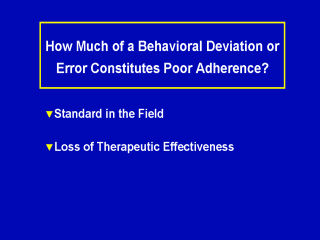 |
The issue we still confront that we really don't know very
much about is how much of a behavioral deviation or error should we consider a poor
adherence problem and how much is really tolerable for the individual patient? The
standard in the field for research has been that if a person is less than 80% adherent,
they're a poor adherer, and if they're more than 80% adherent, they're a good adherer.
That was based on the very first randomized controlled intervention study that was done by
Brian King in the mid 1970's, where they actually looked at patients who were on
diuretics, looked at their adherence levels by pill count, and looked at their blood
pressure. They said for those people that were taking less than 80% of their medicine,
they did not affect their blood pressure response; for those taking more than 80% they
did. So they used an 80% criterion, and that has been standard in the field since then.
There's only one other database standard and that is based on the lipids clinic program,
which found that 70% adherence to the standard is the degree of cholesterol lowering, and
in fact there was sort of a linear relationship between cholesterol lowering and the
adherence to that particular pill. But just donít know for most treatments the amount of
adherence necessary to have a desirable clinical outcome. |
